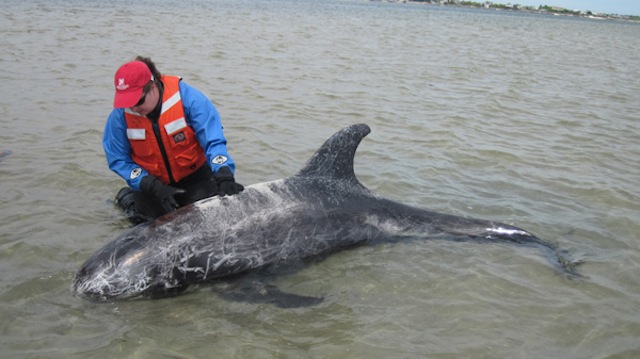The Riverhead Foundation For Marine Research and Preservation responded to a stranded dolphin report on Thursday, June 6 at Ocean Beach on Fire Island to find a Risso Dolphin stranded on a sand bar.
A Risso Dolphin is one of the largest types of dolphins and belongs to the same family as false killer whales, pygmy killer whales, melon-headed whales, long-finned pilot whales, and short-finned pilot whales. According to the National Oceanic and Atmospheric Administration, the Risso can be found in temperate, subtropical and tropical waters of 50-86°F (10-30°C) that are generally greater than 3,300 feet deep. They are known to be found in groups of 5 to 50 animals, but groups typically average between 10 to 30 animals. They have been reported as solitary individuals, pairs, or in loose aggregations in the hundreds and thousands. Occasionally this species associates with other dolphins and whales. Their diets consist of mostly fish, krill, octopus, cuttlefish, and squid.
The Riverhead Foundation For Marine Research is dedicated to researching and helping marine wildlife. They operate the New York State Marine Mammal and Sea Turtle Stranding Program, and is the only authorized organization of its kind in the state of New York. Since its’ inception in 1996, over 4,000 marine species have been rescued from the shores and beaches in New York State.
The Risso Dolphin that was rescued is now safely in a holding tank at the research centers facilities and being checked and monitored in hopes of figuring out why she came so far inland.
“Generally these sort of dolphins stay about 40 or so miles off shore,” Julika Wocial, the Rescue Program Supervisor for the research center noted. “ So as of right now, we are not exactly sure what is wrong with her.”
The team of volunteers and doctors are watching her closely though. Wocial says that is possible that they won’t know what or if there is anything wrong with her for weeks. As with most animals, sometimes symptoms don’t present themselves directly and easily. And unfortunately, the survival rate of dolphins being rehabilitated is between 5 to 10 percent.
 |
|
Risso Dolphin being rescued. (Photo: The Riverhead Foundation For Marine Research and Preservation) |
For now though, Wocial and the rest of the team are happy that she seems to have a healthy appetite and is eating normally.
“She ate the very first day she got here, which is a very good sign,” Wocial said. “She is up to eating 80 pounds of squid a day.”
The only real problem that the facility is facing now is how much she eats. 80 pounds of squid costs about $200 a day. That’s an expensive grocery bill, and the dolphin will be held for at least a couple of months depending on health and the redtape that comes with wild animals such as this.
But right now, the team is staying focused on keeping the newest rescue happy and giving her as much of a sense of normalcy as possible.
“Best case scenarios, there is nothing wrong with her, and we get to release her back into the wild. That’s what we hope for,” Wocial says.
The foundations offers many ways that people can help by “adopting” different rescue animals to help make sure that their needs are met and support them. Money can also be donated, whether just to the cause, or specifically help buy squi
If interested in donating or learning other ways to help their cause, visit the The Riverhead Foundation For Marine Research and Preservation website. If you ever see an animal that you think might need their help or attention, call the 24-hour rescue hotline at 631-369-9829.












